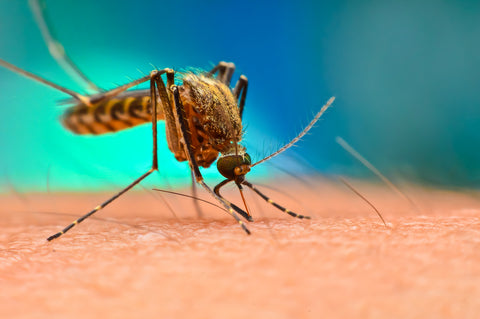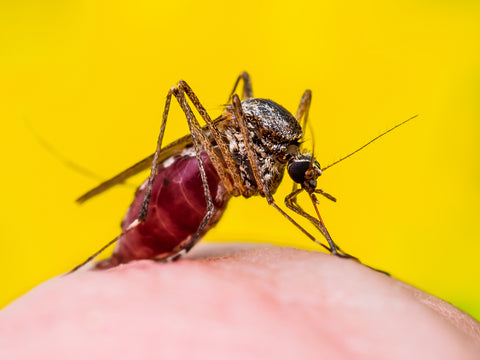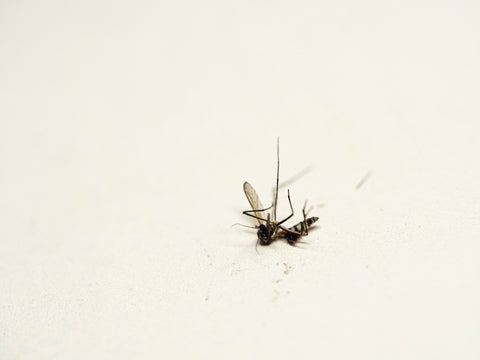Mosquito behavior is a fascinating thing to observe. Take the bugs’ carbon dioxide detection mechanisms, for instance. Seemingly built into mosquitoes from birth, this ability to detect carbon dioxide (CO2) draws them toward humans.
Why? Your grade school science classes have the answer – you breathe in oxygen and breathe out (as well as sweat) CO2.
Unfortunately, not breathing is only an effective form of mosquito control if you’re willing to deal with the grim consequences, so you have to put up with the fact that your breath is an active form of mosquito attraction due to the odor stimulus it provides to the bugs.
Thankfully, there is something you can do to combat the CO2-detecting menace – use color effectively. As it turns out, there are certain colors that keep you safer from the bites, malaria, and yellow fever mosquitoes are capable of spreading.

First – The Colors That Don’t Work
So, what is it about colors and mosquito bites?
According to research published by the University of Washington, it appears that mosquitoes combine their CO2 detection with some form of color detection to figure out where it’s safe to bite. Specifically, the research suggests that mosquitoes likely don’t perceive colors in the same way that we do – i.e., actively seeing them – but can instead detect the wavelengths certain colors have.
The conclusion reached was that the longer the wavelength, the more attractive the color would be to various mosquito species, even if the bug can’t actually “see” the color.
That leads to an obvious next question:
Which colors have long wavelengths?
Sadly, human skin appears to be one of them. The same research points out that skin, regardless of pigmentation or even the individual’s blood type, delivers a long wavelength signal that’s somewhere along the line of that given off by clothing that has red-orange hues.
That means your skin is an active mosquito attractant, so covering it up is your priority. But therein lies another issue – the clothes you use to cover your skin can also be a problem. Based on the long wavelength theory, most dark-colored clothing is out of the picture. Blacks, browns, and deep blues also have longer wavelengths, meaning a mosquito is drawn to them, especially once it’s detected CO2 emanating from the source.
There are a few theories for why mosquitoes prefer dark colors. One of the most convincing is that dark colors offer heat absorption. That’s attractive to mosquitoes – they love warm places – so they’re naturally drawn to the wavelengths these colors have because they’re constantly seeking sources of heat and humidity.

How You Can Use Color to Your Advantage
While all of this means that people who prefer darker colors are more prone to mosquito bites (apologies to any goths reading right now), it also means you can use color as a form of defense.
Wear light-colored clothing to make mosquitoes less attracted to you.
White, green, blue (colors) are all solid choices if you’re looking for colors that mosquitoes actively despise. Though in the case of the latter, you have to be careful with shade – sky blue ahead of dark blue if you want the shorter wavelength to be in play.
In fact, one study, which involved creating dots of color to see which the mosquitoes would go toward, found that the bugs actively avoided greens, blues, purples, and whites. The researchers even went so far as to wear a green glove – pre-sprayed with CO2 – before inserting their hands into chambers containing mosquitoes.
The bugs ignored the green-gloved CO2-covered hand entirely.

Could Color Be Your Mosquito Repellent Solution?
Unfortunately, the answer is a somewhat ambiguous “yes and no.”
On the one hand, wearing lighter colors does appear to have a repellent effect on mosquitoes because they detect the shorter wavelength and thus feel less “safe” in attacking you. It’s the same theory as the one that suggests that the bugs are less likely to bite if you’re standing in direct sunlight – they hate the light.
But there are other factors at play. Your breath, sweat, and even your skin are active mosquito attractants, and you can’t get rid of all three of those issues. So, perhaps the best course of action is to cover your skin with light-colored clothing before masking the scent of the CO2 in your breath and sweat with an odor that mosquitoes hate – such as the citronella in Tougher Than Tom’s Mosquito Eliminator Spray.
Combine the forces of lighter colors and relevant odor stimulus and you have a powerful mosquito deterrent for when you’re out and about.


